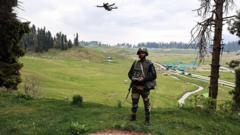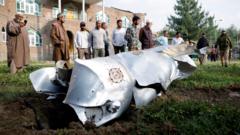As both nations accuse each other of drone assaults and retaliatory actions, military experts warn of a dangerous shift in warfare dynamics, emphasizing the need for restraint amid rising tensions.**
Tensions Rise as India and Pakistan Engage in Drone Warfare**

Tensions Rise as India and Pakistan Engage in Drone Warfare**
The historic drone exchanges between India and Pakistan mark a new era in their longstanding conflict, raising concerns of escalation in the nuclear-armed region.**
The conflict between India and Pakistan has witnessed a significant and alarming evolution, morphing into what could be termed the first drone war involving nuclear-armed neighbors. Following a series of reported drone assaults on military installations in Indian-administered Kashmir from Pakistan, both nations have engaged in an escalation of attacks, accusations, and an unprecedented reliance on unmanned aerial vehicles.
On Thursday, Indian military officials alleged that Pakistan executed waves of drone strikes targeting three critical military bases within Indian territory, a claim that Pakistan promptly rejected. Meanwhile, Islamabad boasted of intercepting and neutralizing 25 Indian drones over several major cities, including Karachi and Lahore. In response, India's silence was palpable, fueling both domestic and international fears about the rising stakes in South Asia.
Experts note that these tit-for-tat drone exchanges represent a perilous transition in the long-standing rivalry, with deadly implications. The integration of drones, described as "silent and remote," underscores a distinct shift from conventional warfare to technologically advanced tactics, which may challenge escalation control.
"The Indo-Pak conflict is entering a drone-dominated era where unmanned technologies will be crucial in determining both sides' strategic decisions. The outcome may dictate future engagements on this contentious frontier," noted Jahara Matisek, a professor at the US Naval War College. The escalated hostilities could potentially lead to either mitigation or intensification of conflict, with drone warfare reshaping the conflict's landscape.
Reports indicate previous cross-border exchanges have led to considerable casualties on both sides. Projections include at least 36 fatalities in Pakistan due to Indian aerial assaults, while Indian sources claim Pakistani shelling has killed approximately 16 civilians. This vibrant exchange of accusations is compounded by mutual threats of retaliation and defense countermeasures.
As both countries continue to enhance their drone capacities, Indian military experts assert that their advancements stem from Israeli technology, highlighting a measurable shift in capability and strategy. With a recent $4 billion deal to procure advanced US MQ-9B Predator drones, some strategists predict India is firmly positioning itself to leverage drone warfare to its advantage.
Conversely, Pakistan's military has long invested in integrating a diverse drone fleet, including systems from China, Turkey, and domestic developers, paving the way for enhanced capabilities and future combat operations. Analysts argue that this arms race, characterized by new technologies, will only complicate the already volatile relations between these two nations.
While the current exchanges reflect a tactical response to immediate provocations, experts caution that they may be a precursor to more substantial military engagements. The strategic implications of this emerging conflict continue to reverberate, raising critical questions about the implications for regional stability and global security.
In conclusion, as both India and Pakistan navigate this uncharted territory of drone warfare, the potential for miscalculation and escalation remains a pressing concern. With nuclear capabilities at play, the stakes have never been higher, underscoring the urgent need for diplomatic interventions to de-escalate tensions and foster dialogue amid the unfolding crisis.

















